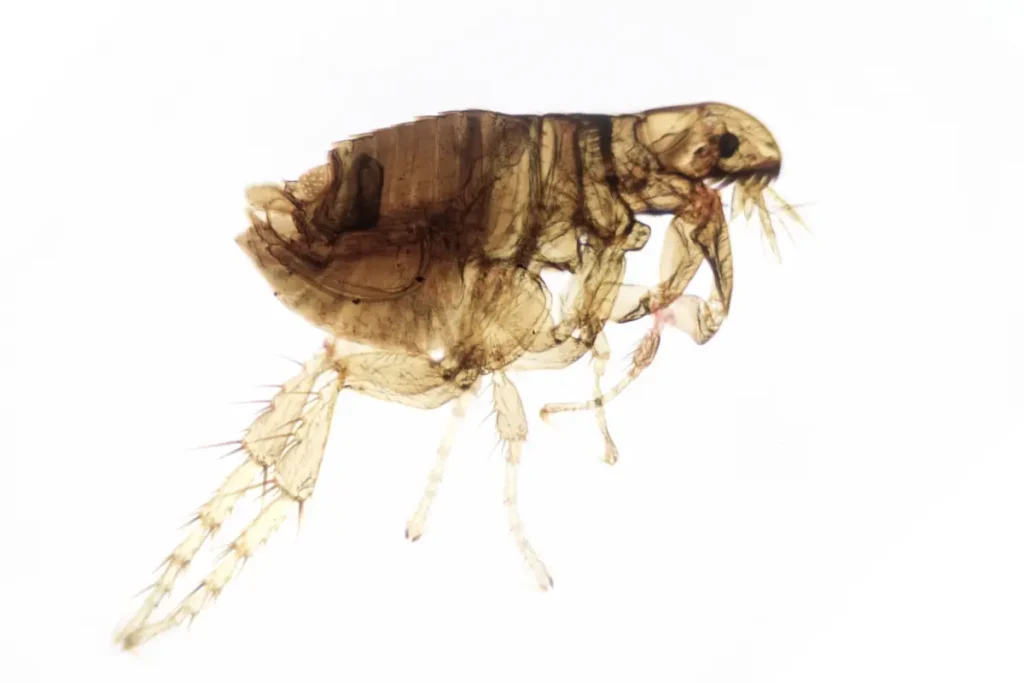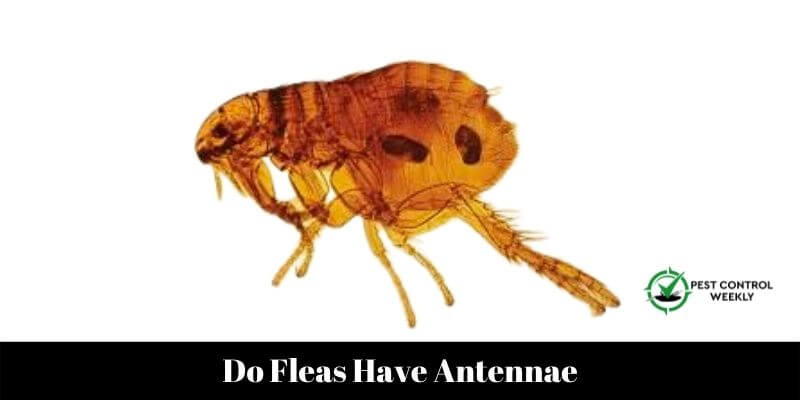Fleas are microscopic parasites that feed on the blood of warm-blooded creatures. They are roughly the size of a speck of dirt. They are rigid-bodied, dark reddish-brown insects. Fleas have six legs and no wings as adults. Do fleas have antennae?
Yes, fleas have two antennae. Mechanoreceptors and chemoreceptors are sensory organs found on flea antennae that can detect touch, smell, heat, humidity, and vibration. They are crucial in the search for hosts.
Male fleas identify females by utilizing their antennae to collect hormonal information. To learn more about flea antennae, read the whole article.
Siphonaptera Antennae
Antennae are located on the sides of the heads of fleas. A little behind the eyes are where the antennas are positioned. They were sunken in large depressions known as antennal fossae. The fossae shield the antennae, which are fragile sensory organs, from harm when fleas crawl through host hair. The grooves allow the antennae to be raised at will.
There are three segments in the antennae. The club, Clava, or flagellum is the term for the top portion. The bottom segment is known as the scape, the middle segment as the pedicel, and the upper segment as the flagellum. The flagellum is an oblong, flattened structure with nine total subsegments.
Male fleas’ antennae are essential for a fruitful mating process. They have disc-shaped clasping organs on their inner surface. These organs have a gland that secretes something sticky, like glue. When a male approaches a female, he raises his antennae, slides under her, and clasps them to her stomach.
Do Flea Larvae Have Antennae?

Yes, flea larvae do have antennae. While larvae lack eyes and wings, they have antennae that allow them to sense their surroundings. The larva forms a cocoon around itself when it is prepared to develop into an adult flea. Flea eggs hatch into flea larvae, which are off-white and resemble small worms between 2 and 5 millimeters. The antennae of flea larvae might not be visible to the unaided eye.
Flea larvae, however, lack both eyes and legs. Initially white and maggot-like, their body gradually darkens as they consume the adult fleas’ feces.
In addition to feces, larvae consume a variety of organic substances, including food particles, dead skin, insects, and feathers.
Flea larvae walk by tensing and relaxing the muscle in their skin tube. They use their lips to affix themselves to the surface.
Do Cat Fleas Have Antennae?

Yes, Cat fleas in adult form have three pairs of legs and antennae. They can reach 18 of an inch and are typically flat-shaped. Usually, dark brown cat fleas can turn red after eating.
For cat fleas, C. felis, the function of the antennae during mating is less critical than it is for other flea species. Male cat fleas primarily utilize their claws to latch onto the legs of females after initially grabbing them with their antennae.
From the flea egg to the adult flea, there are four main phases in the cat flea life cycle. Depending on the climate, this cycle might last between two weeks and one year. Adult fleas start feeding immediately and can remain for several months if not eliminated by grooming or insecticides.
Do Fleas Have Long Antennas?

No, fleas don’t have long antennae. The antennae usually are three segments long and short. On the side of the skull, some depressions serve as antennae holders. Fleas are all raptor-like. The hind legs are specialized for jumping and are spinose with big coxae.
Ten segments make up the flea’s abdomen, and the reduced tergum I and sternum I am lacking. The sensillum is a sophisticated sensory organ located near the top of the flea’s abdomen. Flea larvae have a worm-like appearance, 13 body segments, and no appendages.
Although the head capsule lacks eyes, it is extensively sclerotized. The antennae are one-segmented, and the mandibles are brush-like. The anal struts are seen on the terminal body segment. The caterpillar experiences three instars before it begins to build a pupal cocoon. The pupa is adecticous and exarate; in some species, pupal wing buds are present, indicating that fleas may have had winged ancestors.
What Type Of Antennae Do Fleas Have?
The antennal fossae are where fleas’ antennae are located. The head is divided into anterior and posterior portions by the antennal fossa. Three modified segments make up the thorax. They have long legs but lucky wings.
Flea antennae are small and resemble clubs. They can’t be seen with the naked eye, though, because they are so tiny. The transparent, translucent, and soft antennal cuticle is thin. Most species don’t have a distinctly tan appearance. Compared to females, males have longer antennas.
Why Do Fleas Have Antennae?

Fleas have antennae that serve sensory purposes. Sensory receptors and chemoreceptors are sensory organs found on flea antennae that can detect touch, smell, temperature, humidity, and vibration. They are crucial in the search for hosts. Flea males use their antennae to collect hormonal data to locate females.
Male fleas’ antennae are essential for a fruitful mating process. They have disc-shaped clasping organs on their inner surface (copulatory suckers). These organs have a gland that secretes something sticky, like glue.
A male will raise his antennae as he approaches a female, crawl under her, and clasp them to her abdomen. The antennal attachment may remain in place throughout mating in some flea species. Cat fleas, on the other hand, have males who instantly retrieve their antennae after joining their genitalia. However, they may do so again if he is startled or rejected.
Conclusion
Fleas have antennae on both sides of their skulls. A little behind the eyes are where the antennas are positioned. The antennal fossae, which are deep channels, contain them. The fossae shield the antennae, which are fragile sensory organs, from harm when fleas crawl through host hair.
The grooves allow the antennae to be raised at will. Mechanoreceptors and chemoreceptors are sensory organs found on flea antennae that can detect touch, smell, heat, moisture, and vibration. They are crucial in the search for hosts. Flea males use their antennae to collect hormonal data to locate females.
References
Zhang, Y., Fu, YT., Yao, C. et al. Mitochondrial phylogenomics provides insights into the taxonomy and phylogeny of fleas. Parasites Vectors 15, 223 (2022).
Zając Z, Kulisz J, Woźniak A. Flea Communities on Small Rodents in Eastern Poland. Insects. 2020; 11(12):894


